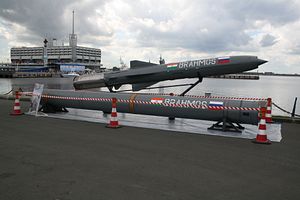Having resolved long-standing issues regarding intellectual property concerns, India and Russia may be ready to offer up their jointly developed BrahMos supersonic cruise missile for export. According to a recent report by IHS Jane’s Defence Weekly, India plans to reinvigorate plans to offer the missile to Vietnam. As I’d discussed in The Diplomat in September 2014, Hanoi had shown interest in the platform for some time. Indian Defense Minister Manohar Parrikar will visit Vietnam later this month to discuss the sale with his Vietnamese counterpart.
The BrahMos has the distinction of being one of the deadliest cruise missiles to exist, primarily due to its supersonic cruising speeds and precision. Though the BrahMos has a shorter range than other cruise missiles, it remains the fastest anti-ship cruise missile, capable of traveling at speeds of up to Mach 3.0 while sea-skimming to avoid detection. Several variants of the BrahMos exist; the Indian Army, Navy, and Air Force operate surface-launched, ship-launched, and air-launched variants. A submarine-launched variant has completed successful testing from underwater launch platforms, but remains inoperative.
Defense collaboration between India and Vietnam has intensified since Hanoi first demonstrated interest in the BrahMos. Amid concerns about Chinese behavior in the South China Sea, Vietnam is seeking to bolster its defenses to deter the People’s Liberation Army-Navy. A year ago, Vietnamese Defense Minister Phùng Quang Thanh was in New Delhi to sign agreements on defense cooperation and a Joint Vision Statement outlining a road map for increased defense collaboration.
During a visit by former Vietnamese Prime Minister Nguyen Tan Dung in 2014, New Delhi agreed to supply Vietnam with four maritime patrol vessels. Meanwhile, Indian Navy vessels continue to make regular port calls at Vietnam’s Cam Ranh Bay. Vietnam is increasingly at the center of India’s “Act East” policy, which seeks to enlarge New Delhi’s footprint in East and Southeast Asia.
With Russian and Indian agreement on export conditions for the BrahMos, it is likely that Hanoi will conclude a deal to import the cruise missile. Both Moscow and New Delhi have pledged to only import the BrahMos to states that are fundamentally “friendly to both India and Russia.” Vietnam fits the bill in that regard and had already been deemed to be a “friendly country” by a joint Indo-Russian supervisory council in 2011.
The conclusion of a BrahMos deal with Vietnam would represent a major success for India’s defense industry. For Vietnam, the anti-ship variant would represent a potent deterrent tool. Hanoi has sought to offset its qualitative and quantitative disadvantages against China by investing in tool enabling asymmetric strategies, including Kilo-class submarines. The BrahMos may well be next.

































